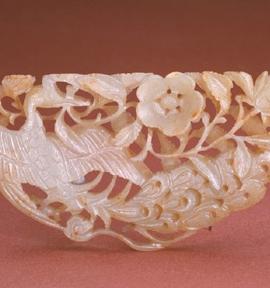The tracedstan jade is actually an Islam jade or jade. The name of the marker is written by Emperor Qianlong personally. Qing Dynasty is located in the north of India, including Kashmir and Western Pakistan. The jade materials in the Qing Dynasty are mostly Heyu jade in the southern Xinjiang and Yerji in the south. Tracerystan jade craftsman likes to use solid color jade carving, that is, all colors, especially choose white jade or white jade, transparent crystal. This is in stark contrast to the traditional Chinese jade jade or jade carvings. The locals believe that the food utensils made of jade can be used to avoid poisons. Therefore, they are generally practical bowls, cups, dishes, plates, pots, and other utensils. They are not commonly seen in Chinese jade. The decoration of these jade articles is very local cultural features. Some of them are inlaid with gold and silver filaments, and red, green, yellow, blue, and other colored gems or glass; the decorative patterns are mostly plant mosaics. And mainly clematis; embroidered animal eye with different colored stones. In addition to these decorative techniques, water-mill technology is also used. The carcass is thin and thin, and there is a saying that “the West Kunming jade is extremely clever, and the water mill is thin like a piece of paperâ€. 100% Polyester Solid Bedding Set Duvet Sheet Set,Solid Flat Sheet,Solid Bedding Sets,Colorful Sheet Sets changxing sanxing textile co.,ltd , https://www.sxhometextile.com
During the reign of Emperor Qianlong of the Qing Dynasty, the House of Representatives set up a workshop dedicated to imitation of traces of Tsentuoyu, and Suzhou's special workshops also had imitations. These "Xi Fan Zao" jade devices did not follow the same pattern of copying trace dossue jade, but instead took advantage of its unique shape, smooth design, and thin-walled carcass, combined with the traditional methods of Chinese craftsmanship to create a jade article with Xifan style. . These Chinese and Western jades directly affect the style of Chinese jade. Most of the modern jade stoves are Chinese-style, and the decorative patterns are Western-style, just like the Chinese-Western combination of furniture. .
China and India have similar jewellery manufacturing costs, but China has a long-term policy on gold imports and India does not; about 60% of India's gold market is not regulated, while in China, the government monitors all jewellery markets; China surpassed last year. India has become the world’s largest gold consumer. As the appreciation of *** and bank deposits reached 7.5 billion U.S. dollars, China’s gold demand may remain strong, reaching 1,000-1,100 tons in 2014 and reaching 1,350 tons/year in 2017. In India, the demand for gold in 2014 is expected to be 900-1,000 tons.
In the past five to ten years, Indian jewelry has transformed itself from the obscure Black House workshop to the center stage of the International Jewellery Arena. This rapid rise in status has two reasons:
First of all, it will focus on the shift from gold to diamonds, that is, with diamonds as the embellishment and gold as the backdrop. Although 80 percent of India's jewelry market is still occupied by gold, this subtle change is far-reaching.
Second, the Indians’ purchasing psychology has shifted from pure preservation to the identification of design values ​​and knowledge of the texture and rarity of the gemstones. The Indian jewelry industry has developed rapidly in the past three years. Nowadays, its diamond cutting process has become the industry leader. Nowadays diamonds used in jewelry are cut and polished in India.